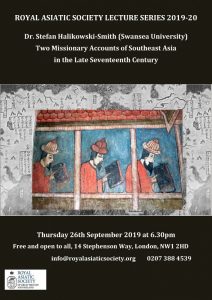Treasures Uncovered
Yesterday, a researcher came to look at some of our maps. The maps are an area of the Collections which still need some sorting and ordering, so I needed to work through the shelves to find the maps that had been requested. That done, I became a little nosy and decided to find out the contents of some unlabelled cardboard tubes. The first tube revealed architect’s floor plans for 56 Queen Anne Street, one of the previous properties of the Royal Asiatic Society. The Royal Asiatic Society leased the premises at 56 Queen Anne Street from 1947 to 1988. The Society moved to 56 Queen Anne Street in time for the Anniversary Meeting on 16 May 1947. A 63 year lease was taken from the Howard de Walden Estate at a cost of £8000. As the Grosvenor Street (their previous location) lease had been sold for £25000 this was an astute financial move for the Society. I had already created a catalogue for the records we have for this property, so I was able to update the catalogue and add the plans to the kept records.
The next cardboard tube revealed something very different…
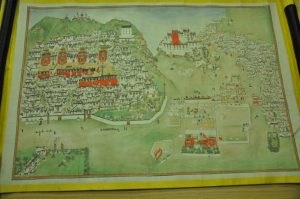
This painting is described in the Head catalogue, but we had been unable to locate it when a recent researcher had inquired about it. We had found a companion picture (not in Head catalogue but now catalogued as 088.002)…
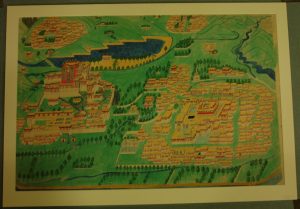
The Shigatse painting is described in the Head catalogue as a painting on silk by a Tibetan artist c.1889, measuring 63 x 92.2 cm. It was collected by the diplomat and explorer William W. Rockhill and is featured in the Journal of the Royal Asiatic Society (1891), Part 2 (April) where it is reproduced as a black and white plate to accompany an article by Rockhill on Tibet: A Geographical, Ethnographical, and Historical Sketch, derived from Chinese Sources. Rockhill, it seems, is an interesting character. He was born in America but spent his teenage years in France where he attended the École spéciale militaire de Saint-Cyr, and his studies included Tibetan. After graduating he joined the French Foreign Legion. In 1876, he returned to America to marry his childhood sweetheart. On her gaining an inheritance, Rockhill took an unpaid position with the American legation in Peking but was promoted to a paid position on gaining good language skills. He undertook exploration in China, Tibet and Mongolia in the 1880s. He published books and articles in both America and England, and received the Gold Medal of the Royal Geographical Society. He is widely known for his promotion of an Open China Policy to the American Government at the time of the Boxer Rebellion. He continued in various diplomatic roles in both Europe and Asia throughout his life. Rockhill is also well-known among Sinologists and Southeast Asianists for his seminal translation and commentary, with Friedrich Hirth, of Zhao Ruguo’s text on ancient Chinese and Arab Maritime Trade
Having found this painting, I then became curious about a package labelled as “Chinese scroll”. On opening, I found this…
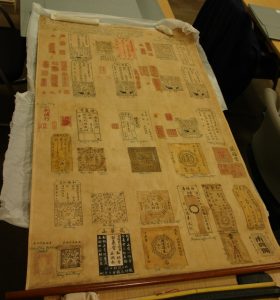
The writing in the top left-hand corner reveals that “Towards the end of 1889, proclamations were widely issued in the Straits Settlements, to prepare all classes for the abolition of all Secret Societies, and special notices were given to the Societies registered as Dangerous under the old Ordinance that they would not be registered under the new Ord: No.1 of 1889, but must wind up their affairs by the 30th June 1889. The Singapore and Penang Societies in 1890 delivered up their chops and books, and Messrs: Powell and Hare were present at the Central Lodge when the headmen of the 6 Triad branches made formal renunciation by the burning of the original diplomas, which constituted them part of the mother-organisation – the Gi-Hin”. The text is signed by William Cowan, Protector of Perak.
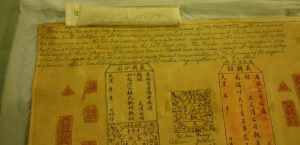
This banner seems to be connected with another banner in our possession – again bearing William Cowan’s name and concerned with the triad societies.
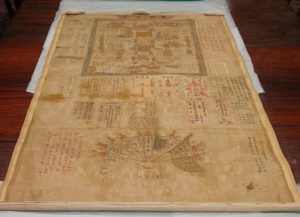
This was is also signed by Cowan and dated 1897. As yet it is unclear how these came into the possession but it is good to now have these two items housed and listed together which will enable researchers to come and discover more about them.
The Society’s lectures begin their new season on Thursday 26 September, 6.30pm, when Dr. Stefan Halikowski-Smith from Swansea University will lecture on “Two Missionary Accounts of Southeast Asia in the Late Seventeenth Century”. All are welcome to attend.
